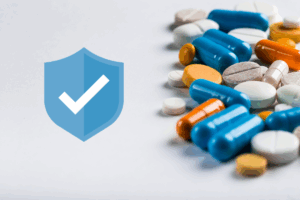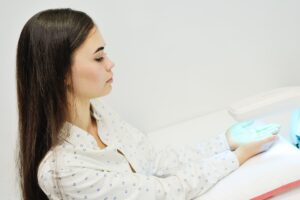National CooperativeRx continually monitors the pharmaceutical pipeline. The pharmacy market is dynamic and complex, and it’s important to understand how changes may impact your plan and which drugs bring the highest value. Our quarterly NCRx Pipeline Reports highlight some of the newest therapies coming to market and are not intended to imply formulary placement or coverage by CVS Caremark.
At-Home Infusion of Furosemide Reduces Hospitalization Risk in Heart Failure Patients
Furoscix® (furosemide subcutaneous infusion): With a significant portion of healthcare dollars spent on hospital admissions, interventions that can prevent them are a point of focus for healthcare innovators. Heart failure is one condition that consumes a sizeable share of hospital dollars, usually related to exacerbations of the chronic condition. The standard of care for a heart failure exacerbation typically involves administration of IV diuretics, commonly known as “water pills,” to relieve excess fluid and congestion from the body. These are usually given in the hospital while the patient is monitored. scPharmaceuticals, Inc is vying for an October 8th FDA approval for their device which is designed to deliver a subcutaneous (i.e., injected under the skin) dose of furosemide over five hours, at home, for certain groups of patients with heart failure. The therapy was studied against IV furosemide in a clinical trial and the relief of fluid between the two groups was similar.7 Additional studies have shown Furoscix® to be associated with a 37% lower rate of heart failure-related hospitalization and a reduction in heart failure-related healthcare costs of $17,000 per patient.8,9 Furoscix® and its corresponding data fit nicely into the emerging trend of “hospital at home.” Borne mainly out of the COVID pandemic, where more patients were treated at home instead of in a healthcare facility when possible, the concept has caught on; patients [with non-life-threatening conditions] are given the tools and support to receive care at home instead of the hospital, resulting in cost savings and sometimes better outcome data. Of course, that all takes a significant amount of coordination. The most difficult pieces of the treatment process with Furoscix® may be just that—coordination of timing and access to the product. Because faster fluid reduction is tied to better outcomes, the manufacturer will need to be certain patients are able to access the product quickly and easily. Another key issue will be price. There does appear to be cost savings associated with reduced hospitalizations, but if the drug is priced exorbitantly high, insurers may opt for a higher level of care available at a healthcare facility instead.
Anticipated launch: Fourth quarter, 2022
Impact: Moderate. There are about six million people in the United States with heart failure; about 80% of these people have stage two and three disease.10
Price: Unknown. Generic oral furosemide costs pennies per month, while an 80mg IV dose costs about $5 in addition to the administration cost.
Two Drugs Repurposed for Depression Likely to Disrupt the Market
Auvelity (dextromethorphan and bupropion): Approved on August 18, 2022, Auvelity® is the first oral N-methyl D-aspartate (NMDA) receptor antagonist to gain an indication for treating depression. Spravato®, an NMDA receptor antagonist in a nasal spray formulation, was approved in 2019 for treatment-resistant depression, but uptake has been slow as it is a controlled substance with strict prescribing restrictions in place. Auvelity® is actually a combination of two existing drugs which are not controlled substances: Bupropion, an antidepressant commonly known as Wellbutrin®, and dextromethorphan, commonly known as Delsym® cough syrup. The exact mechanism of action of dextromethorphan in depression is unknown but it has shown success in bringing relief of symptoms fairly quickly. In clinical trials, Auvelity® was compared to placebo or bupropion alone. About 40% of patients taking Auvelity® saw their depression go into remission compared to only about 16% of those in the bupropion and placebo groups.1,2 In key trials for Spravato®, about 50% of those taking an oral antidepressant along with Spravato® were able to achieve remission. Those taking an oral antidepressant along with a placebo nasal spray had a 30% chance of remission.3 Clearly, both Spravato® and Auvelity® have remarkable efficacy data, but it’s hard to estimate the real-world effect when the placebo effect was also clearly remarkable in the trials. It’s also important to note that Spravato® trials were done in patients with resistant depression but Auvelity® trials excluded those patients as well as anyone with bipolar disorder, panic disorder or OCD. Still, it’s likely Auvelity® will disrupt the antidepressant market given its relatively new mechanism of action and oral administration. However, it’s not likely to be used as a first-line agent, and it’s quite possible uptake of Auvelity will be lessened by providers opting to use bupropion along with over-the-counter dextromethorphan.
Anticipated launch: Fourth quarter, 2022
Impact: Moderate, mostly replacement spend
Price: Unknown. Likely to cost less than Spravato but more than existing branded antidepressant. For reference, Trintellix costs $5,000/year and Spravato® costs $36,000/year
Stool Transplant Enema Results in Remarkable Rate of Sustained Remission from C. Diff. Infection
Rebyota® (fecal microbiota, live): Ferring Pharmaceuticals is looking for a fourth quarter, 2022 approval for their first-to-market fecal microbiota transplant product, Reybota®. The product has been studied for the treatment of recurrent Clostridium Difficile infection (CDI), an intestinal infection caused by disturbances in the gut bacteria, usually from recent antibiotic use. CDI is typically treated with antibiotics specifically targeted to the bacteria, but unfortunately, the infection recurs in about a third of patients and can lead to serious outcomes including death. Fecal microbiota transplant (FMT) has been studied for many years for CDI but has failed to garner FDA support due to a lack of product standardization and a few adverse outcomes resulting in death. Rebyota® is made with 50 g of stool collected from donors who complete a rigorous screening process. The samples are then blended, filtered and frozen in a standardized process subject to quality controls. In an open-label clinical trial including patients with inflammatory bowel disease (IBD) and irritable bowel syndrome (IBS) (who are normally excluded from C. difficile trials), 74% of participants remained symptom-free six months after treatment with Rebyota®.4 For reference, two other treatments for prevention of CDI recurrence have success rates of between 47-53% at six to twelve weeks.5 One downside to the new treatment is its rectal administration: It’s given as a small-volume enema at the time the patient is treated for a recurrent CDI. Ferring Pharmaceuticals is working on an oral version of the product to increase accessibility and patient acceptance. Given its remarkable efficacy, the product is likely to have good uptake by providers and patients who are comfortable with the administration of enemas. One big factor which could hamper uptake and insurance coverage is price, given Rebyota®’s Orphan and Breakthrough Therapy designations. The cost of other products to treat the same condition is $1,200 to $4,000 per course. When approval occurs, the product will go on CVS’s New-to-Market-Block list until it is reviewed by the Pharmacy and Therapeutics Committee.
Anticipated launch: First quarter, 2023. FDA’s Vaccines and Related Biological Products.
Advisory Committee (VRBPAC) meeting will be September 22, 2022
Impact: Low. Will likely increase when oral formulation is available.
Price: Unknown. Alternative treatments for the same condition are $1,200 to $4,000/course
SPN-830 Reduces “Off” Episodes for Parkinson’s Patients–at a Physical and Financial Cost
SPN-830 (apomorphine subcutaneous infusion): Pending approval in October 2022, SPN-830 would become the third apomorphine product to the market for Parkinson’s Disease (PD) “off” episodes. “Off” episodes result when a patient’s maintenance medication wears off or stops working. During these episodes, PD symptoms return in sometimes unpredictable ways. Management of “off” times typically starts with increasing the dose of existing medications or adding another oral PD drug. However, as the disease progresses, “off” periods increase and the response to therapy decreases. In recent years, two formulations of apomorphine, a dopamine agonist, have been approved by the FDA for treatment of “off” episodes: Apokyn® and Kynmobi®. SPN-830 is given as a continuous subcutaneous infusion via a specially designed device and would be the first apomorphine product to be approved for continuous treatment of “off” episodes. An open-label study of SPN-830 showed the mean daily “off” time decreased by 3.0 hours, which was statistically significant.6 For reference, existing standard therapies typically reduce “off” time by about 60-90 minutes per day. Despite the encouraging efficacy data, there are some drawbacks which may blunt uptake of this product. First, price: Most standard maintenance drugs for PD are relatively inexpensive generics, but SPN-830 is likely to cost thousands of dollars per month. Kynmobi® and Apokyn® can cost anywhere from $10,000 to $300,000 per year, depending on dose; SPN-830 is likely to fall somewhere in this range. The other major drawback to apomorphine therapy is the risk of intense side effects from the medication. Therapy initiation must be done under the direct supervision of a physician, as apomorphine can cause sudden drops in blood pressure and pulse. Apomorphine also frequently causes significant nausea, so much so that the manufacturer recommends starting an anti-nausea medication a few days before beginning treatment. Despite the costs and the risks that come with treatment, PD is a devastating disease and there is a need for more advanced treatments. Insurers will likely cover the therapy with a prior authorization, requiring trials of standard, generic drugs first.
Anticipated launch: Fourth quarter, 2022
Impact: Low. There are about one million people in the United States with Parkinson’s Disease; a small percentage of these people have advanced disease.
Price: Unknown. Likely to be at the high end of the range of $10,000-$300,000 per year
A Brief Update on Hemophilia Therapies in the Pipeline
AMT-061 (Etranacogene Dezaparvovec) from Uniqure is a gene therapy for hemophilia B and is expected in November 2022. Hemophilia B is generally less severe than hemophilia A, and we expect this therapy only to be approved for moderate to severe hemophilia B disease.
Roctavian® from Biomarin is a highly anticipated gene therapy for hemophilia A and has been delayed by the FDA multiple times. The company was reportedly planning to resubmit data to the FDA in September, which may mean an FDA decision sometime in the spring of 2023. We expect Roctavian® to be labeled for patients with severe hemophilia A who do not have factor VIII inhibitors. They will also need to test negative for antibodies to the adeno-associated virus serotype 5, which serves as the vector for the gene therapy.
Both of these gene therapies are expected to be one-time treatments and are not expected to be covered on the pharmacy side of the benefit.
Concizumab, which is not a gene therapy and will compete with Hemlibra®, may gain approval in 2023. The expected cost is $500,000-$1,000,000/year. It appears to have subcutaneous administration like Hemlibra®, so it’s likely to be a pharmacy benefit product.
Finally, there are additional hemophilia therapies in the pipeline which are not expected until 2024 or later. These include gene therapies, factor replacement and other disease modifying drugs.
Additional Pipeline Updates:
Drug Name/Indication | FDA Approval Date | Cost* | Comments |
|---|---|---|---|
Oxlumo (lumasiran) for primary hyperoxaluria type I (PHI) (expanded indication) | October 6, 2022 | $500,000 to $1,000,000/year | • Rare genetic condition resulting in overproduction of oxalate crystals
• Drug lowers oxalate levels in patients with poor kidney function due to PH1, including those on dialysis |
Omaveloxolone for Friedreich’s ataxia (FA) | November 30, 2022 | $300,000 to $500,000/year | • FA most common hereditary ataxia in the United States: 4000–5000 people affected
• Loss of muscle control leading to clumsy movements
• Drug activates Nrf2, part of a pathway that decreases inflammation and oxidative stress and improves mitochondrial function |
Adalimumab biosimilar (Alvotech) | Rejection on September 5, 2022 | Unknown | • Complete response letter: Problems with manufacturing facility
• Problems must be fixed before Alvotech can resubmit
• Alvotech still plan to be ready for launch on 7/1/23 |
*Wholesale Acquisition Cost (WAC)
1. Iosifescu DV, Jones A, O’Gorman C, et al. Efficacy and safety of AXS-05 (dextromethorphan-bupropion) in patients with major depressive disorder: A phase 3 randomized clinical trial (GEMINI). J Clin Psychiatry 2022; 83(4):21m14345.
2. Tabuteau H, Jones A, Anderson A, Jacobson M, Iosifescu DV. Effect of AXS-05 (dextromethorphan-bupropion) in major depressive disorder: A randomized double-blind controlled trial (ASCEND). Am J Psychiatry 2022 Jul;179(7): 490-499.
3. Popova V, Daly EJ, Trivedi M, et al. Efficacy and safety of flexibly dosed esketamine nasal spray combined with a newly initiated oral antidepressant in treatment-resistant depression: A randomized double-blind active-controlled study TRANSFORM-2. Am J Psychiatry 2019; 176: 428-438.
4. Chopra, T, et al. Microbiota restoration therapy for recurrent clostridium difficile infection (PUNCH CD3-OLS) (CD3-OLS). ClinicalTrials.gov identifier: NCT03931941. Updated September 15, 2022. Accessed September 19, 2022. https://clinicaltrials.gov/ct2/show/NCT03931941?term=punch+cd3&draw=2&rank=1
5. Paschos P, Ioakim K, Malandris K, et al. Add-on interventions for the prevention of recurrent Clostridioides Difficile infection: A systematic review and network meta-analysis. Anaerobe 2021 Oct; 71:102441.
6. Supernus submits NDA for SPN-830 for continuous treatment of ON-OFF episodes in adults with Parkinson’s Disease who have failed two treatments. 2020. Available at https://ir.supernus.com/news-releases/news-release-details/supernus-submits-nda-spn-830-continuous-treatment-episodes.
7. Gilotra NA, Princewill aO, Marino B, et al. Efficacy of intravenous furosemide versus a novel, pH-neutral furosemide formulation administered subcutaneously in outpatients with worsening heart failure. J Am Coll Cardiol 2018; 6(1): 65-70.
8. Konstam MA, Udelson JE. Avoiding treatment in the hospital with Furoscix for the management of congestion in heart failure – a pilot study (AT HOME-HF). ClinicalTrials.gov identifier: NCT04593823. Updated May 9, 2022. Accessed September 20, 2022.
9. scPharmaceuticals Inc. presents late-breaking FREEDOM-HF study data at the Heart Failure Society of America annual scientific meeting 2021. 2021. Available at https://scpharmaceuticalsinc.gcs-web.com/news-releases/news-release-details/scpharmaceuticals-inc-presents-late-breaking-freedom-hf-study.
10. Ahmed A, Aronow WS, Fleg JL. Higher New York Heart Association Classes and increased mortality and hospitalization in heart failure patients with preserved left ventricular function. Am Heart J 2006 Feb; 151(2): 444–450.




